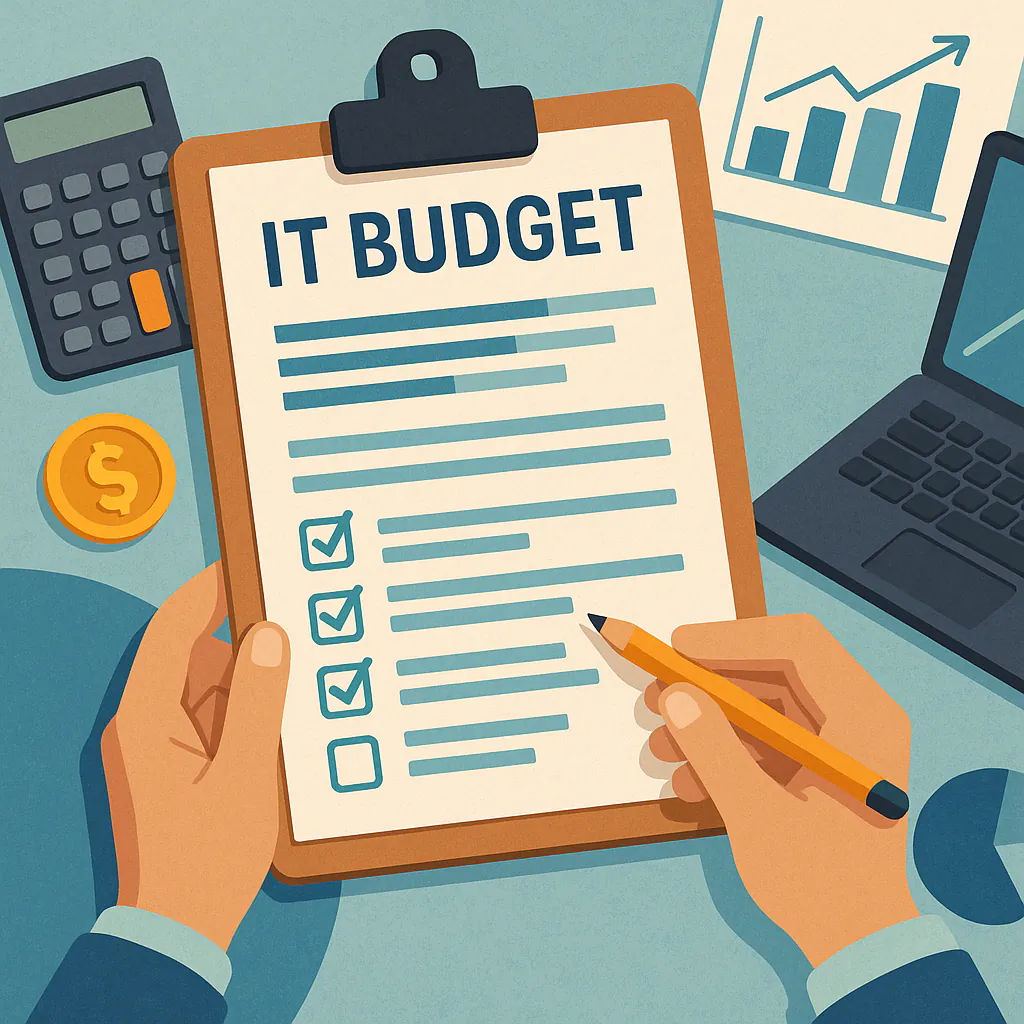Why Most IT Budgets Fail Before the Year Even Starts
Every year, companies set out to build an IT budget that’s supposed to cover their technology needs, only to find themselves blowing past it within months. Why? Most IT budgets are based on guesswork, reactionary thinking, or outdated assumptions.
A functional IT budget isn’t just a spreadsheet—it’s a strategic plan. One that balances operational needs, risk management, and innovation. Done right, it keeps you ahead of problems instead of always reacting to them.
If you’re tired of overspending, under-investing, or never knowing where your IT dollars go, this guide is for you.
What Should Be Included in an IT Budget?
At a minimum, a reliable IT budget should cover:
- Hardware costs: Workstations, laptops, servers, multifunction printers (MFPs), etc.
- Software licensing and subscriptions: Everything from Microsoft 365 to print management tools like PaperCut or uniFLOW.
- Support and maintenance: Vendor contracts, managed services, system upgrades.
- Network infrastructure: Routers, firewalls, cabling, wireless access points.
- Cybersecurity: Tools (firewalls, antivirus, endpoint detection), training, audits.
- Backup and disaster recovery: Cloud services, failover solutions.
- IT staffing: Salaries, benefits, and training for in-house teams.
- Contingency funds: Reserved for unplanned upgrades or urgent repairs.
But a great IT budget also accounts for business objectives and planned changes, such as expansions, new compliance requirements, or shifts to hybrid work.
Step 1: Start With Business Goals, Not Tech
Before pulling last year’s numbers or calling vendors, meet with leadership and department heads to understand the company’s plans. Are you:
- Hiring more remote workers?
- Opening a new location?
- Adopting a new ERP system?
- Facing new cybersecurity risks due to client demands or regulatory shifts?
Your IT budget should map directly to these strategic goals. For example, if you’re hiring remotely, that affects hardware provisioning, VPN licenses, cloud storage capacity, and even printer security protocols.
Step 2: Audit What You Already Have
You can’t build an effective budget without knowing what you already own and pay for. Conduct a thorough IT asset and service audit:
- Inventory devices and their age. Are there upcoming replacement costs?
- List every software license. Are there redundant tools?
- Review all vendor contracts. Are you overpaying? Can you bundle or renegotiate?
Managed print services (MPS) are a great example. Many companies spend thousands a year on printers, supplies, and maintenance, often spread across departments. A vendor like Doceo can centralize this, identify inefficiencies, and give you predictable monthly costs.
Step 3: Categorize Your Costs
Break your budget into three categories:
- Operational (Opex): Day-to-day IT spending—support, maintenance, cloud services.
- Capital (Capex): Larger investments like servers, MFP upgrades, or network infrastructure.
- Strategic: Initiatives that align with growth, innovation, or competitive edge, such as automation, customer portals, or compliance tools.
This clarity helps decision-makers see where IT is supporting the business now versus building for the future.
Step 4: Budget for Security Like It’s Inevitable (Because It Is)
Security isn’t a “nice to have”—it’s a non-negotiable. But it’s often the line item most underfunded or completely overlooked.
Even print devices can be a weak link. Networked printers and MFPs, if not secured, can be exploited through firmware vulnerabilities, unsecured protocols, or data stored on internal hard drives.
Budget for:
- Print security assessments (or MPS plans that include them)
- End-user security training
- Regular patching and firmware updates
- MFA (multi-factor authentication)
- Data loss prevention (DLP) tools
Step 5: Plan for Growth—and Surprises
Technology doesn’t stand still, and neither should your budget. Built-in flexibility:
- Allocate a contingency fund (typically 5–15%) for unexpected needs.
- Include scalable solutions (like cloud services or MPS agreements) that grow with you.
- Forecast multi-year purchases—hardware upgrades, for example, often follow a 3–5 year cycle.
By planning beyond the current year, you reduce the risk of panic purchases or budget derailment later.
Step 6: Communicate in Business Terms, Not IT Jargon
IT budgets are reviewed by non-technical leaders. Avoid acronyms, abbreviations, or tech-specific terminology unless clearly explained.
Instead, frame each line item in terms of:
- Cost savings (e.g., “Switching to MPS reduces print costs by 25%”)
- Risk reduction (e.g., “Upgrading firewalls eliminates unpatched vulnerabilities”)
- Revenue impact (e.g., “Improved uptime leads to more productive client billable hours”)
Bonus Tip: Don’t Go It Alone
Building an IT budget that works isn’t just about technology—it’s about relationships. Work with trusted partners who understand your business, not just your infrastructure.
At Doceo, we help clients across industries create smarter, more accurate budgets by:
- Conducting technology assessments
- Identifying cost overruns and hidden risks
- Recommending scalable solutions that align with long-term goals
Whether it’s right-sizing your print environment, modernizing your office tech, or navigating security standards, we’re here to help you get it right before the fiscal year begins.
Final Thoughts: IT Budgeting Isn’t a Cost Exercise—It’s a Business Strategy
A well-built IT budget reflects a business that’s in control of its future. It’s proactive, not reactive. Aligned, not scattered. Focused on outcomes, not just inputs.
If your current budget doesn’t feel that way, it’s time to try something new.
Ready to Build a Better IT Budget?
Schedule a free technology assessment with Doceo. We’ll help you map your current IT landscape, uncover hidden costs, and build a budget that works.
Visit Doceo to Get Started | Call 888-757-6626 | Find a Location Near You


